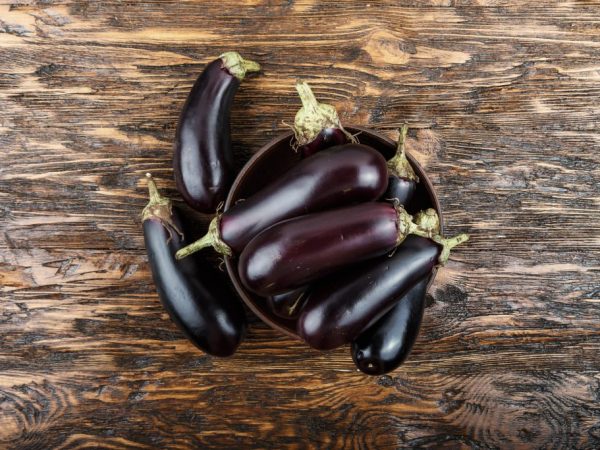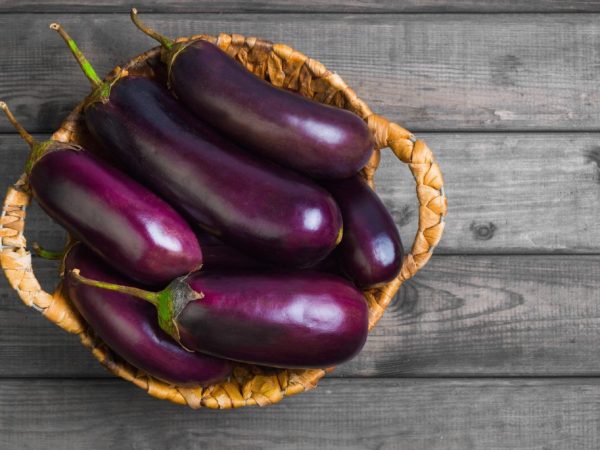Description of eggplant diamond
Eggplant Diamond of category F1 has a high yield, good transportability and long shelf life. We will consider a detailed description of the variety in the article.

Description of eggplant diamond
Characteristics of the variety
The Almaz eggplant variety was developed in Russia at the beginning of 1980. In 1983, it was decided to add it to the State Register of the Russian Federation. The company Elita is engaged in the supply of seeds. Ideal for growing in all regions of the country. In cooler regions, planting should be done in a greenhouse environment. Due to the density of fruits and plants, harvesting can be done using mechanized equipment.
The characteristics of the variety indicate that the growing season is only 120 days from the moment the first shoots appear. The yield is high: about 10 kg of selected products can be harvested from 1 m2.
Description of the bush
Consider the characteristics of a bush of this variety.
- Diamond eggplant bushes are compact, their maximum height is 50-60 cm;
- uniform branching, which allows you to get an early harvest;
- leaves are medium in size, rich green, with a matte surface;
- leaf shape is wide and oval;
- purple veins on the leaves;
- the petioles are purple, they do not have thorns, which greatly simplifies the harvesting process.
Description of the fetus
The fruits are cylindrical in shape with a glossy surface. The length of an individual fruit can be from 10 to 19 cm, depending on the quality of care. The width can vary from 3 to 7 cm. At the time of technical maturity, the fruits are of a delicate purple hue. As soon as they reach biological maturity, they change color to rich brown. The average weight of a single fruit is 150-200 g. The yield is high: about 10 kg of selected products can be harvested from 1 m2.
The description indicates that the color of the flesh is green with a slight creamy sheen. The inside of the fruit contains many seeds that are not suitable for planting.
Taste and use
The pulp is characterized by a high density, which makes it possible to prepare various dishes from this product. As such, taste is not observed. The only fact that needs to be noted is the lack of bitterness.
Diamond eggplants are versatile in use: you can prepare delicious fresh salads, which are often used during dietary meals, casseroles, vegetable stews, or simply bake the pulp of these vegetables in the oven, adding various protein products (eggs, cheese, etc.).
Almaz eggplants can be transported over long distances. For this reason, this crop is grown for the purpose of further sale.
Growing process

The most popular growing method is seedling
Correct agricultural technology is the key to a high-quality harvest. The cultivation of this variety can be carried out in several ways. Each of them is suitable for a specific region.
In the central and southern regions, it is possible to plant crops using a seedless method.The warm climate protects the plants from frost. In all other areas, it is recommended to plant seedlings in order to protect the crop from diseases and pests.
Seedling method
Planting of this variety is carried out in early March. There are several main stages of planting using seedlings.
- It is necessary to prepare containers in which fertile soil (loamy or black soil) is poured.
- Now you should plant the seeds directly. If you will plant them in a common container, then you need to adhere to a distance of 7 cm. For better safety of the seeds (from breaking the roots or dryness), it is better to plant in separate glasses. The sowing depth is 1.2 cm.
- The planted seeds must be watered with warm water and covered with plastic wrap. It can be removed after 10 days. This is done so that the first shoots appear much faster.
- Move the container with seeds to a warm room with a temperature of about 20-27 ° C. With the appearance of the first shoots, the temperature is reduced to 13-18 ° C. This action is necessary for a powerful root system to form.
- 2 weeks after planting, you need to feed the seeds with a urea solution (20 mg per 2 liters of water).
- Planting in open ground is carried out 30-40 days after planting the seeds. During this time, it must form and be prepared to move to a permanent place. You can plant only those seedlings on which 2-3 pairs of leaves have formed.
- The planting site should be well lit and not shaded by other plants.
- Landing scheme 60x40 cm.
Landing in open ground
The first step is to prepare the seeds at home. To do this, the seeds must be soaked in warm water, literally for 20-30 minutes. Those that float must be thrown away, since they are not suitable for landing. The remaining planting material should be planted in warm soil conditions, that is, only the soil that has warmed up to a temperature of 14-16 ° C is suitable. This is usually done in mid-May.
Seeds should be planted at a distance of 5-7 cm from each other. As soon as the first shoots appear, it is important to remove the small seedlings, leaving only the large ones. Seedlings should be located at a distance of 30 cm from each other.
Care
Almaz eggplants are not demanding to care for. The irrigation schedule should be normalized - this should be done once every 3 days, and only with warm water. Irrigation procedures are carried out in the morning or in the evening to reduce the risk of moisture evaporation under the influence of sunlight. After each watering, the area should be weeded and weeds removed. This will get rid of the top crust on the soil, which can lead to root rot. Loosening allows you to make sure that the required amount of oxygen and nutrients gets into the root system.
Top dressing is carried out in several stages.
- 3 weeks after planting the plant in open ground. At this point, organic fertilizers should be preferred. The ideal option is to use urea (100 ml per 2 liters of water).
- 20 days after the first one. It should be diluted in 10 liters of water with 30 mg of superphosphate and 1000 ml of urea. About 2 liters of solution are poured into each bush. At the time of active germination of seeds, 2 kg of mullein should be diluted in 10 liters of water and 1.5 liters of solution should be poured into each plant.
It is important to form the bush correctly. For best growth and high yields, only 3 stems should be left. Due to the heavy and dense stem, each bush needs a garter to support it.
Pests and diseases
Almaz eggplants are resistant to phytoplasmosis, viral mosaic and apical rot. Resistance to fusarium and late blight is noted. The only drawback of this variety is its susceptibility to pests.
The most common enemies of the Diamond are beetles and aphids. You can get rid of beetles by picking them by hand, or using chemical insecticides. Chlorophos (40 g per 10 l of water) should be used as chemicals.Spraying is carried out with a similar solution every 10 days. You can fight aphids with the help of a copper-containing preparation Oxyhom (50 ml per 10 liters of water). With its help, spraying is carried out at intervals of 7 days.
Conclusion
Almaz eggplants are popular in the modern market. Many people grow this crop for the purpose of further sale, because it is not only high-yielding, but also does not undergo diseases. The collected products can be transported over long distances, they are stored for several months without loss of marketability and taste. Basic cultivation and minimal maintenance allow even beginners to plant this crop.


